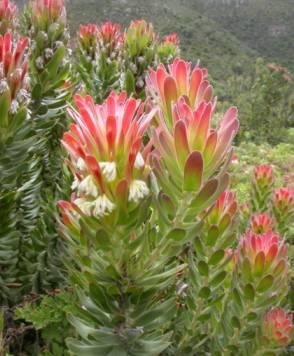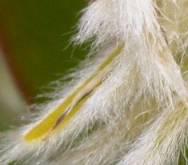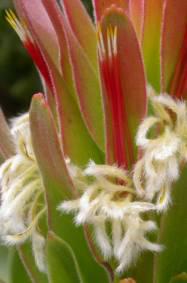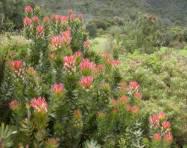Mimetes cucullatus
Mimetes cucullatus (L.) R.Br.
Family: Proteaceae
Common names: common mimetes, common pagoda, red mimetes, red pagoda ( Eng. ); rooistompie, stompie (Afr.)
Introduction
Mimetes cucullatus is eye-catching, unusual and colourful all year round, and it is among the easiest members of the protea family to grow.

Description
Description
Mimetes cucullatus is a multi-stemmed, densely-leaved shrub, 0.5 to 2 m tall with an upright, bushy growth habit. The leaves are oblong-elliptic, 25-55 mm long and are neatly and symmetrically arranged along the branches. New growth is bright red.
The unusual flowerheads of Mimetes distinguish this genus from the other members of the protea family. All members of the protea family have small flowers grouped in conspicuous flowerheads. The individual flowers are tubular and have a perianth made up of four perianth segments, sometimes three are fused and one is free. When in bud, the segments touch each other but don't overlap, and as the flower opens they separate and curl back to expose the style.

The tip of each perianth segment is slightly widened and has a depression in which a single anther rests. The pollen that it sheds sticks to the top portion of the style, called the pollen presenter. The stigma is a small groove at the tip of the style, and self-pollination is prevented because the stigma is not receptive when its own pollen is being produced. At the base of the flower, inside the perianth tube, are four scale-like nectaries and a minute superior ovary, which produces a dry nut-like fruit. In Mimetes the flowers are grouped into small dense cylindrical inflorescences of 3-16 florets produced in the axil of a leaf, and up to 15 of these cylindrical inflorescences can occur on one flowering stem.

Looking at Mimetes cucullatus we see wool-like tufts sticking out from between brightly coloured leaves towards the tips of the branches. Each 'tuft' is a group of 4-7 florets, the cylindrical inflorescence, and each inflorescence is produced directly below a leaf, which in this species partly encloses the inflorescence, like a hood. The actual inflorescence is not particularly showy, but the whole flowering stem is very colourful: the leaves that enclose the inflorescences are red at the tip, shading to a bright yellow and then into bright green. The creamy white 'tufts' are actually the bearded tips of the thread-like perianth segments and hold the anthers; and the styles are dark red, tipped with yellow and rear up right underneath the red hood-like leaf. Flowers are produced nearly all year round, but the peak flowering season is from early spring to late summer-autumn (August to March). Seeds are released 2-6 months after flowering.
Conservation Status
Status
Mimetes cucullatus is not threatened and is the most widespread of all the mimetes.
Distribution and habitat
Distribution description
It is found on sandy soils, on sandstone slopes and flats, most frequently on the cool, moist, south-facing slopes and damp flats. It occurs from the Koue Bokkeveld Mountains to Kogelberg to Elim Flats, Caledon Swartberg, Cape Peninsula; Potberg; Riviersonderend Mountains, eastern Langeberg to Outeniqua and Kouga Mountains; Klein Swartberg and Rooiberg. It grows from sea level to 1 200 m. All the other species of Mimetes occur in small areas and are mostly classified as rare, and one species, M. stokoei is extinct. It could be the resprouting strategy of M. cucullatus that makes it so much more successful than its relatives.
Derivation of name and historical aspects
History
The name Mimetes is derived from the Greek mimetes meaning imitator or mimic. Why this name was chosen is not clear; although the species do resemble each other to some extent and the foliage is quite similar to that of the genus Leucospermum ; in every other respect the genus Mimetes is outstandingly unique. Cucullatus means hood-like and refers to the way the floral leaves partly enclose the flowers, forming a hood-like structure over them.
The common name stompie, which means little stumps, is possibly derived from the fact that all that is left after a fire are little stumps. Rooi means red, referring to the colour of the new growth and the floral leaves. The name could also refer to the way the branches appear to have been squarely lopped off to form what appear to be red-tipped stumps.

The genus Mimetes belongs in the protea family (Proteaceae) and consists of 14 species, all of which occur in the Western Cape, from Porterville to the Kouga Mountains.
Ecology
Ecology
Mimetes cucullatus is the only mimetes that is a resprouter i.e. it survives fires by resprouting from a large, woody, underground rootstock. All the others are re-seeders, i.e. they are killed by fire but seedlings germinate when conditions are suitable after the fire; some also have thick, corky bark and although damaged, do sometimes survive fires. The flowers are pollinated by sunbirds and the sugarbird. The seeds have elaiosomes at both ends joined by a ridge down one side. An elaiosome is a grey-white, oily protuberance, which is very attractive to ants and is eaten by them. Ants collect the seeds and carry them off to their underground nests where the elaiosomes are eaten off. Removing the elaiosome does not damage the seed. It is left whole and safe in the ant nest where it remains viable for many years. Seeds left lying at the base of the parent are often eaten by rodents.
Uses
Use
In the past, the bark was used for tanning. Mimetes cucullatus has great potential as a cutflower; the flowering stems are relatively long, they last well, can be packed without being damaged and the plants resprout strongly after being pruned.
Growing Mimetes cucullatus
Grow
Mimetes cucullatus is a rewarding garden plant, giving colour all year round and forming a neat, compact shrub. Grow it in a sunny position in sandy, well-drained, acidic soils. Give it plenty of water during autumn-winter-spring and moderate amounts during summer, making sure that the water drains away. Feed it with well-rotted compost and/or low-dose or slow-release fertilizers, preferably organic, and steer clear of manures and other strong fertilizers. When in doubt, plant fynbos plants on a slope in an area that gets some degree of air movement. Being a resprouter, Mimetes cucullatus responds well to hard pruning. Older, established plants can be rejuvenated and flowering encouraged by being pruned back to the base; they will resprout vigorously.

This mimetes is a colourful addition to any garden, it is a good choice for the fynbos garden and an excellent plant for the coastal garden. It can also be grown in large containers. It is not suited to very cold climates, but should survive short periods of cold, from -1 to -3°C.
Mimetes cucullatus can be propagated by seed or cuttings.
Mimetes cucullatus has a very low percentage germination (4 to 5% in tests conducted by Brown & Botha 2004) and it does not respond to treatment with Instant Smoke Plus Seed Primer. No further tests have been done to find out which dormancy-breaking treatments they do respond to. In the nursery we have found that seed is best sown in late summer to autumn, when the changes in temperature between the hot days (18-23°C ) and cold nights (8-10°C ) act as the trigger for germination to occur. Good nursery hygiene is essential, use a sterile medium and dust the seed with a fungicide to prevent pre- and post-emergence fungal infections.
Cuttings from new growth can be taken in spring or autumn and should be treated with a rooting hormone and placed on heated benches with overhead mist spray. Rooted cuttings should be hardened off away from the mist spray before being potted up.
References
- Brown, N.A.C. & Botha, P.A. 2004. Smoke germination studies and a guide to seed propagation of plants from the major families of the Cape Floristic Region, South Africa South African Journal of Botany 70: 559-581.
- Jackson , W.P.U. 1990. Origins and meanings of names of South African plant genera. University of Cape Town Printing Dept., Cape Town.
- Protea Atlas Project http://protea.worldonline.co.za
- Rebelo, A. (Tony). 2001. Proteas. A field guide to the proteas of southern Africa , edn 2. Fernwood Press, Cape Town.
- Smith, C.A. 1966. Common names of South African plants. Memoirs of the Botanical Survey of South Africa No. 35.
- Vogts, M. 1982. South Africa's Proteaceae, know them and grow them . Struik, Cape Town.
Credits
Alice Notten
Kirstenbosch NBG
February 2005
Plant Attributes:
Plant Type: Shrub
SA Distribution: Western Cape
Soil type: Sandy, Loam
Flowering season: Spring, Early Summer, Late Summer, Sporadic/All year
PH: Acid
Flower colour: Red, White, Cream
Aspect: Full Sun
Gardening skill: Average
Special Features:
Horticultural zones










Rate this article
Article well written and informative
Rate this plant
Is this an interesting plant?
Login to add your Comment
Back to topNot registered yet? Click here to register.